Dr. Jane Goodall Visits With Animal Radio
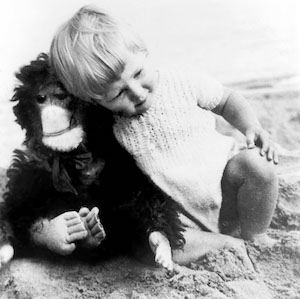 World Renown Anthropologist Dr. Jane Goodall tells us about her experience growing up around chickens and chimps. Even today she still lectures, with over 300 speaking engagements a year. Dr. Goodall also has her hands in the deodorant business, lending her name to environmentally friendly, cruelty-free and sustainable products.
World Renown Anthropologist Dr. Jane Goodall tells us about her experience growing up around chickens and chimps. Even today she still lectures, with over 300 speaking engagements a year. Dr. Goodall also has her hands in the deodorant business, lending her name to environmentally friendly, cruelty-free and sustainable products.
Hal tells Dr. Goodall that while he would love to, he really has no way to interact and really get to know primates like she has. Dr. Goodall quickly corrects him and says all humans are primates, so he must mean non-human primates. She then goes on to tell Hal that there are some really good chimpanzee exhibits in zoos and sanctuaries. These sanctuaries contain chimps that have been rescued from bad zoos, circuses and from medical research. Another way to get up close with primates is to go down to South America where you can go and see various monkeys out in the forest. So there are different ways that you can learn about our cousins.
When Dr. Goodall was one and a half years old, her father gave her a stuffed chimpanzee. There were a few of them made when the first chimpanzee was born in the London Zoo. The chimp was named Jubilee, because it was a jubilee year of the King and Queen.
Everyone thinks that it was because of that toy that Dr. Goodall ended up studying chimpanzees. But of course it wasn't, because nobody knew anything about them at that time. They were exotic. She wouldn't have thought it was possible to study them. She went to Africa with the goal of living with any sort of animal out in the wild and writing books. In Africa, Dr. Goodall met Dr. Louis Leakey, who is the one who suggested she study chimpanzees.
Since a young age, animals have always fascinated Dr. Goodall. As a child, she would watch the hens to see where the eggs came from. To do this, she hid in a small stuffy henhouse waiting for a hen to come in. Sometimes she would wait around four hours, which she thinks most four-year-olds probably wouldn't have that kind of patience. It seems she was born with a curiosity and was fortunate to have an amazing mother who supported her interests. Even though her mother was really worried because Jane was lost for four hours, she didn't get angry when Jane finally rushed towards the house all excited. Dr. Goodall feels a different kind of mother might have crushed that early curiosity and she might not have gone on and accomplished what she has. Dr. Goodall's mother always encouraged her and after the British authorities resisted the idea of a young woman living among wild animals in Africa, her mother even agreed to accompany her for four months.
Dr. Goodall explains that the first time she went to Africa, her mother didn't accompany her. At that time, she was invited by a school friend and stayed for about one and a half years. During this time, Dr. Leakey asked her if she would study with him. She then waited another year until he found the money. Dr. Goodall explains that she never went to college, so it was hard to find someone who had the faith in this crazy idea. And then the British authorities, in then what was called Tanganyika, the crumbling remains of the British Empire, refused to let Dr. Goodall go on her own. That's when her mother volunteered. Dr. Goodall thinks that Dr. Leakey twisted her mother's arm a bit, because he wanted someone who wouldn't compete with her.
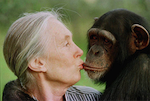 So how does Dr. Goodall see the role of zoos? Does she see them as partners or as more problematic in preserving primates in the wild? She says it honestly depends on the zoo. She says there are some creatures that she would never want to see in a zoo like whales and dolphins and fortunately that's beginning to get through to people. Also, elephants shouldn't be in zoos either. However, there are zoos that are getting better and better. They have great education programs. They're putting money and people into conservation in the wild.
So how does Dr. Goodall see the role of zoos? Does she see them as partners or as more problematic in preserving primates in the wild? She says it honestly depends on the zoo. She says there are some creatures that she would never want to see in a zoo like whales and dolphins and fortunately that's beginning to get through to people. Also, elephants shouldn't be in zoos either. However, there are zoos that are getting better and better. They have great education programs. They're putting money and people into conservation in the wild.
To this day, many people in conservation say, "Well, when I was small I went and saw these animals in the zoo and watched them for hours. I knew I had to grow up and help them." Again, Dr. Goodall says it all depends on the animals and the zoos. She has seen exhibits were chimpanzees have large appropriate groups. They also have lots of enrichment, which is the main problem with zoos, because the animals get bored. Keepers now understand their needs and she thinks they actually have a pretty good life.
These days, Dr. Goodall travels about 300 days a year mostly speaking about environmental crisis. She explains how one person can personally person affect positive change. She says she meets so many people who are aware of the mess that we've created on this planet as well as the terrible things that are happening. This makes people feel helpless and hopeless and therefore they do nothing. But she always says to people, "You know, each day that we live, every single one of us, we make some sort of impact. Thinking about what we buy, where did it come from? How is it made? Did it harm the environment? Does it involve cruelty to animals like intensive farms? Is it cheap because of child slave labor?" So find out a little bit about what you buy and make ethical choices. If just one person did this, it wouldn't do a thing. However, there are now millions of people who are beginning to think this way. So if we look at the cumulative effect of millions and millions of ethical choices, we can buy products that haven't harmed animals, that haven't harmed the environment and that hopefully give back a little.
Schmidt's Naturals is one of those products that make cruelty free products. Nothing's tested on animals and they don't harm the environment. They recently made a new cruelty-free deodorant and they asked Dr. Goodall what her favorite flower smell was. She told them Lily of the Valley. Their new deodorant is now Lily of the Valley scented and the Jane Goodall Institute gets five-percent of every stick sold.
For many years, Dr. Goodall was in the wild recording documents. She says she thinks back on them with great nostalgia. Recently, National Geographic released her latest documentary called "Jane." Using a trove of never-before-seen footage, the film tells the story of Jane's early explorations and research in Tanzania, focusing on her groundbreaking fieldwork, her relationship with her cameraman and husband Hugo van Lawick, and the chimpanzees that were the subject of her study.
 The documentary takes Dr. Goodall right back into the skin of a 26-year-old Jane and the feeling of once again being back among those chimpanzees that she got to know so very well including Flo, Fifi, David Graybeard and Goliath. It's a very nostalgic feeling for her. However, Gombe is no longer the same. Most of the chimps she really knew so well have passed on. They can live 60 years, but it was 60 years ago that she began. Now the area has many tourists and Dr. Goodall feels she was so lucky that she had that world to herself.
The documentary takes Dr. Goodall right back into the skin of a 26-year-old Jane and the feeling of once again being back among those chimpanzees that she got to know so very well including Flo, Fifi, David Graybeard and Goliath. It's a very nostalgic feeling for her. However, Gombe is no longer the same. Most of the chimps she really knew so well have passed on. They can live 60 years, but it was 60 years ago that she began. Now the area has many tourists and Dr. Goodall feels she was so lucky that she had that world to herself.
Dr. Goodall tells us that there are still young people whose passion is to go out and study monkeys or apes in the wild. If you really are passionate, unlike her, you will probably need a degree. Dr. Leakey chose Dr. Goodall particularly because she hadn't been to college, because he thought she would have a mind that was uncluttered with the scientific reductionism of those times. Animals didn't have personalities, minds or emotions according to science back then. However, Dr. Goodall's dog taught her wasn't true.
When she first dreamed of Africa at the age of 10, everybody laughed at Dr. Goodall. They asked her how she would get there. They told her she didn't have any money in her family and Africa was far away. There's also a war and you're just a girl. However, her mother always said, "If you really want this you're going to have to work extremely hard and take advantage of all and any opportunity and don't give up." This is what she says to young people as she's traveling around. Many of them actually follow their dreams and they get there, even if they haven't got the degree and they're not doing some kind of PhD or something. There are opportunities to volunteer in the sanctuaries in Africa. So there are many, many ways of living with and helping the animals today.
Visit Website
SOLVED: Selecting Pet Insurance
Jason Hargraves, InsuranceQuotes.com
 A common misconception is that pet insurance is similar to human insurance. Jason Hargraves breaks that myth with the truth about pet insurance. The editor of Insurance Quotes tells us what to look out for when picking a policy.
A common misconception is that pet insurance is similar to human insurance. Jason Hargraves breaks that myth with the truth about pet insurance. The editor of Insurance Quotes tells us what to look out for when picking a policy.
Jason Hargraves works for InsuranceQuotes.com on their editorial side. They have a couple of websites and he covers all kinds of topics of insurance, whether it's pet insurance or home or auto insurance. People visiting the sites looking for quotes from various insurance agencies, whether big or small, fund their website. It's like a one stop shopping spot. InsuranceQuotes.com then tries to get them together with an insurance agent that's going to best match their needs.
What Jason tells a person when they are picking out pet insurance is that it's so much different than what you have for you and your family. That can be a good thing or a bad thing, depending upon how you look at it. Pet insurance, as a veterinarian can attest, doesn't work like human insurance. You don't have a co-pay. It's basically an arrangement you have with the pet insurance company. So if your dog is hurt or has a disease, you're probably going to be out of pocket that money until you can get reimbursed. It's then up to you to file the claim with the pet insurance company. This kind of takes the middleman out, which some people enjoy because it puts more control in the pet owner's hand and it's more flexible. Plus, you can use it at any veterinarian office. The vet's office doesn't have to have to be on any kind of special program or even take your pet insurance. So that gives you a lot more flexibility. However, it can come as a surprise if you go to a veterinary office and you expect them to file an insurance claim. It's all up to you.
Do you need pre-approval if you know your dog is going to have surgery? Will the insurance company then pay the veterinarian directly? Jason says he is not aware of anything like this. However, Dr. Debbie tells us that her office operates with a pet insurance company that does this. The company Trupanion does do pre-approvals. She can therefore have a client actually in her lobby and tell them that their dog needs a $2,000 surgery and they immediately get on the horn to Trupanion to figure out how much they will cover. Trupanion also offers a direct pay option to the veterinarian, but it has to be set up in advance. Dr. Debbie feels that some of that is convenience based and establishment of the company with a relationship with a veterinarian. This company is just one example. Dr. Debbie feels that there are others that are looking at that too.
Having a pet insurance company pay directly to a veterinarian is something Jason's not familiar with it, but he says it's great if you can find it. Most of the people he's dealt with have paid up front and then been reimbursed. However, it's an ever-changing field. Pet insurance has gotten very popular in the last few years. Plus, healthcare for pets has gotten so much better. We didn't have all of this great technology before, so the marketplace for pet insurance is really rapidly changing, as he just found out!
Jason says you also know in advance exactly what your pet insurance policy covers, because you can get a policy that can cover a variety of issues for several different price points. So it's good to know what's going to be covered when you're searching for pet insurance. You want to know if accidents are covered and if long-term illnesses are covered, so you have an idea what's going to be covered in the future, which is great.
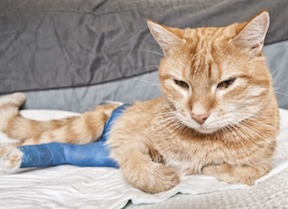 There are a lot of misconceptions as to when to get pet insurance. Dr. Debbie explains that she just heard this the other day in her office when a cat was sick. It turns out the cat had a major illness that just came up and the pet owner turned to a veterinarian in her office and said, "So, how about that pet insurance? I can get that now, right? It will over the costs?" So people think that you get it after your pet is sick to help you pay less. Pet insurance doesn't work that way. When you get pet insurance, you are hedging the bet that your pet will never need that insurance. You don't get pet insurance after they are already sick.
There are a lot of misconceptions as to when to get pet insurance. Dr. Debbie explains that she just heard this the other day in her office when a cat was sick. It turns out the cat had a major illness that just came up and the pet owner turned to a veterinarian in her office and said, "So, how about that pet insurance? I can get that now, right? It will over the costs?" So people think that you get it after your pet is sick to help you pay less. Pet insurance doesn't work that way. When you get pet insurance, you are hedging the bet that your pet will never need that insurance. You don't get pet insurance after they are already sick.
So how much does pet insurance cost? According to Jason, their data from 2017 says the average annual premium to have pet insurance for a dog is about $517 and about $321 for a cat annually. So it's a little cheaper to insure a cat. Cats' medical bills tend to be a little cheaper also. He believes their data also shows that an average routine care vet visit can be around the $200 mark. But if your pet has had an accident, say for example your dog was hit by a car or has something very severe; these averages are not going to be any good to you. You're going to have an extremely high medical bill.
Jason explains that people with dogs tend to get pet insurance way more than people with cats. Dog owners are much more into pet insurance than cat owners. There are about 1.8 million pets in North America that are covered by pet insurance. Jason explains that that sounds like a great amount until you do the math. It's really only about one percent of the cats and dogs in America.
Surprisingly, pet insurance is very popular in Sweden, which is where it all started. The first United States pet insurance policy was issued in 1982 to cover Lassie, which Jason believes had some public relations motivation. The United States has been a little late to the game compared to some other countries.
So is pet insurance like human insurance in the way that if you don't get it for your animal when they are young, its going to cost you a lot more to start it when they are older? Yes, says Jason. In fact, if you were trying to insure a 10-year-old pet, you probably would have a very difficult time finding pet insurance. However, that said, you can find policies that have a variety of exclusions. For instance, your dog may be 10-years-old and so there could be a lot of health issues that may be around the corner. The pet insurance company might then say you should think of something more affordable, which would be an accident only insurance policy. That way, only if he was hurt in an accident would it pay, but it would bring your premiums down. Jason says you can work with insurance companies to get coverage, but he feels at 10-years-old, if you wanted full service coverage, you'd be hard pressed to find, and if you did it would be expensive.
What is it we should be looking out for when we choose pet insurance? Jason says the biggest thing is actually what is covered. Your expenses are going to be different if you have an animal that had an accident, a broken bone or an accidental poisoning or maybe even ingesting objects as opposed to a chronic disease that comes on all of a sudden, like pancreatitis. So really understand what it's covering and make sure you know these items are covered so you're not surprised. And again, many policies will offer just an accident only policy, which is much cheaper. But remember, these policies don't help if your dog develops cancer or has some kind of heart ailment. So you really have to investigate it.
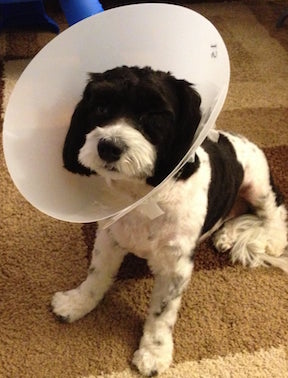 A good idea, according to Jason, is to have a mental checklist. Ask yourself what scenarios may happen to your pet and ask the insurer if it will be covered. You really have to ask the questions and know what's covered. That's the best thing to do when shopping around; whatever's going to give you the peace of mind. Just talk to the insurer and actually give them some case scenarios to find out if they cover them. They can then build you a policy that fits those needs. So there is some flexibility, but obviously you're going to pay more for more coverage, especially if your pet's older,
A good idea, according to Jason, is to have a mental checklist. Ask yourself what scenarios may happen to your pet and ask the insurer if it will be covered. You really have to ask the questions and know what's covered. That's the best thing to do when shopping around; whatever's going to give you the peace of mind. Just talk to the insurer and actually give them some case scenarios to find out if they cover them. They can then build you a policy that fits those needs. So there is some flexibility, but obviously you're going to pay more for more coverage, especially if your pet's older,
If you have a rescue dog that you adopted and don't know their past history, are you going to be denied insurance? Jason explains that there's not going to be a health screening for your dog. Age is important, but as far as preexisting conditions go, that's kind of a loose situation. It again depends on the policy and how they want to cover it. However, your pet's medical records are not going to be as thorough as they would be for human health insurance. Again, you just have to find the right provider. If you do have a dog from a shelter, or you have a dog that's 10 years or older, maybe you don't even know how old your dog is, that's something to be very upfront about because the last thing you want to do is pick a pet insurance company that's going to end up not paying because you forgot to disclose something. So the best thing is to provide your dog's information and let the insurance company know everything upfront, because you don't want to be on the back end of that and find yourself stuck with a huge bill and without the coverage you thought you had.
Jason explains that there aren't any insurance companies better than others when it comes to adoptive dogs, as there are so many new companies coming on board and so many new options. He recommends shopping around. A lot of these new companies are tailor making a lot of these policies to fit consumer's needs. Because a lot of people are getting rescue animals, they could easily create a whole sub-group for that.
Again, there are new companies being added every day and it's a growing field, especially in this country. Just be sure to check the marketplace and see what's out there and what works best for you and your pet.
Visit Website
The Dangers of Doggie Dragon Breath - Dr. Debbie
 Does your dog's breath cause you to gag and turn away? Are your pet's kisses unwelcome due to fetid breath? Many dog owners recognize that distinctive smell which is often accepted as a condition of dog ownership. But stinky dog breath, while common, is actually a symptom of illness and should not be ignored. Doggie dragon breath, just like a blinking traffic light, is a sign of danger ahead. Don't ignore dog breath for what it is - an indicator of oral infection that if left unchecked will impact your dog's health and shorten his lifespan.
Does your dog's breath cause you to gag and turn away? Are your pet's kisses unwelcome due to fetid breath? Many dog owners recognize that distinctive smell which is often accepted as a condition of dog ownership. But stinky dog breath, while common, is actually a symptom of illness and should not be ignored. Doggie dragon breath, just like a blinking traffic light, is a sign of danger ahead. Don't ignore dog breath for what it is - an indicator of oral infection that if left unchecked will impact your dog's health and shorten his lifespan.
What's the big deal about bad breath? It's more than just the smell. Bad breath, also referred to as halitosis, arises from plaque and oral bacteria. Periodontal disease progresses as plaque accumulates, mineralizes into tartar, and inflammation causes destruction of the supportive tissues around the teeth. Dogs don't simply get cavities, rather they will lose their teeth as connective attachments deteriorate. Untreated dental infections jeopardize the health of nearby teeth and may lead to osteomyelitis - infection in the bone. And with time, untreated periodontal disease showers the bloodstream with bacterial products leading to other diseases such as liver, kidney and heart disease.
Fight Halitosis
The best way to control periodontal disease is to assume an offensive attack. Monitor your pet's oral health by flipping up your dog's lip to discover what is lurking underneath. Look for red inflamed gums, yellow or brown accumulation on the teeth, tooth discoloration, or bad breath. Any symptoms of periodontal disease should be addressed with your veterinarian. Have your pet's teeth cleaned regularly at the veterinary office and follow up with home dental care including daily brushing.
These professional veterinary cleanings are important to safely remove mineralized tartar, clean under the gum line, permit a thorough oral exam and take x-rays. Veterinary dental x-rays are an essential tool in detecting problems and have been shown to identify oral disease in 28-percent of dogs and 42-percent of cats that have an outwardly normal mouth.
Don't fall into the hype about herbal spray-on products or 'awake' dental procedures - these only offer a cosmetic improvement in visible tartar, which only covers a small part of the tooth. These methods, often incorrectly touted as a safe alternative to professional cleanings, can't address the 60-percent of a dog's tooth which lies under the gum line - exactly where periodontal disease brews and does its damage.
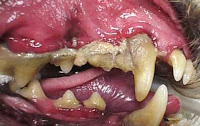 Once you identify that nasty doggie breath, you can be certain some degree of periodontal disease is present and dental intervention is needed. Statistics show that by 3 years of age 80-percent of dogs and cats already have periodontal disease. Don't forget that small and toy breeds of dog have accelerated dental problems diagnosed as young as 1 to 2 years of age.
Once you identify that nasty doggie breath, you can be certain some degree of periodontal disease is present and dental intervention is needed. Statistics show that by 3 years of age 80-percent of dogs and cats already have periodontal disease. Don't forget that small and toy breeds of dog have accelerated dental problems diagnosed as young as 1 to 2 years of age.
Think prevention - have your dog's teeth cleaned and embrace home dental care steps. And the next time you find yourself in a cloud of canine halitosis, you won't turn the other way - you'll grab that toothbrush.
Featured veterinarian known as "Dr. Debbie" on national pet radio program, Animal Radio. Ebook author of "Yorkshire Terriers: How to Be Your Dog's Best Friend"; "Pugs: How to Be Your Dog's Best Friend"; "Mini Schnauzers: How to Be Your Dog's Best Friend"; and "Shih Tzu: How to Be Your Dog's Best Friend." Dr. Debbie's books.
Visit Website
Animal Radio News - Lori Brooks
 Police Officer Shoots Police Dog
Police Officer Shoots Police Dog
A Waco, Texas, police officer shot and killed a police dog last week after the dog bit its handler as the officers tried to serve a warrant. As officers approached a house, the police dog, a Belgian Malinois, turned and bit his handler. Waco PD says, "At that point, another officer on scene was forced to put down the dog to save the officer." This isn't the first episode in which a police dog had to be shot when it attacked an officer in the line of duty. In July 2001, Waco police shot and killed the department's 3-year-old Dutch shepherd named Blur when the dog and its handler were searching for a stolen car suspect and the dog attacked another officer who had approached him from behind. And just last month, a police K-9 officer in Ohio was attacked by his dog as he was trying to verbally correct him, forcing the officer to shoot and kill the dog.
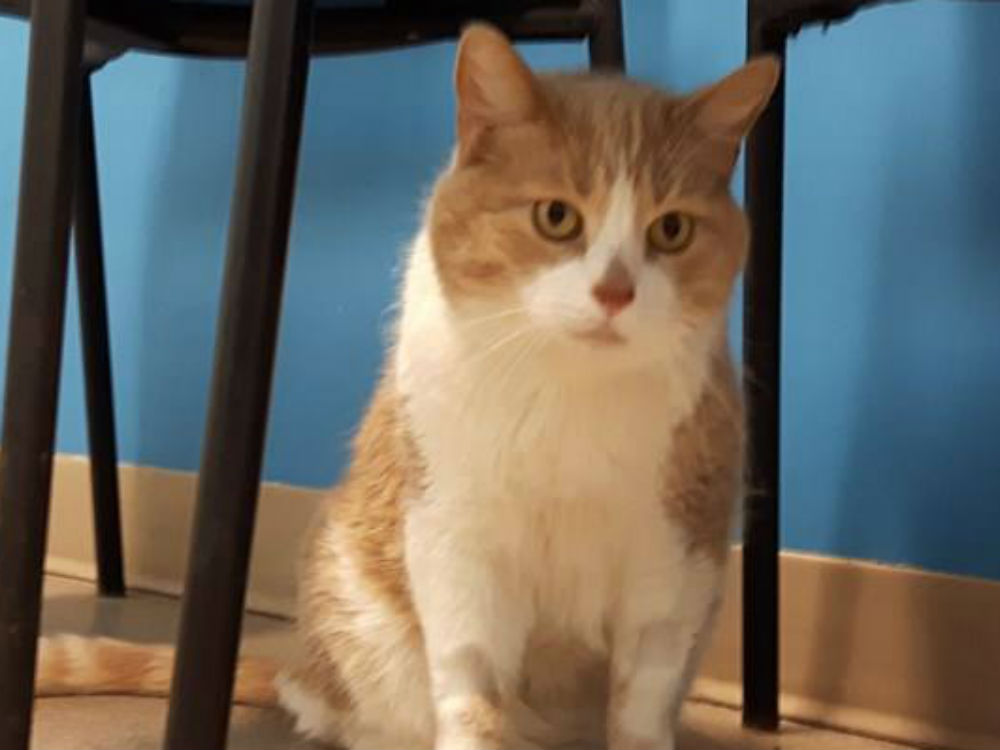 Shelter Won't Identify Adoptive Family of Missing Pet
Shelter Won't Identify Adoptive Family of Missing Pet
A search for a cat has ended in Quebec's highest court with a ruling last week that an animal shelter must reveal the identity of the family that took in the missing pet. The Quebec Court of Appeal upheld a lower court decision ordering that the name and contact information of the adoptive family be handed over to the animal's original owner. The ruling says Sundae, a cat who had been with his previous owner since 2009, wandered off from his home without wearing his collar or tag. That was "on or about" April 13th of this year. After he failed to turn up after more than a week, the owner reported Sundae missing on April 23rd. Two months later, on May 28th, the family was told the cat was at the shelter, but the next day they were told Sundae was in fact already living with a new adoptive family. A judge then ordered the shelter to hand over contact information for Sundae's new family. The animal shelter refused and appealed the decision, claiming Quebec's privacy laws prevented it from disclosing the new owners information. As of now, the saga continues and at last report the orange and white Calico cat named Sundae had not been returned to his original owner.
 Most Popular Toy Breeds
Most Popular Toy Breeds
The most popular small and tiny breed dogs, or those dogs under 30 pounds, according to the AKC are, in 10th place the Boston Terrier; 9th place the Shih Tzu; 8th place the Cavalier King Charles Spaniel; 7th place the Pembroke Corgi; 6th place the Miniature Schnauzer; 5th place the Dachshund, or Wiener Dog; 4th place the Yorkshire Terrier; 3rd place the Poodle; 2nd place the Beagle; and the most popular small breed dog in the country is the French Bulldog.
Who Wrote The Rainbow Bridge Poem?
If you've ever experienced the death of a pet, chances are you've heard of the Rainbow Bridge, a mythical overpass said to connect heaven and Earth. It's also a spot where grieving pet owners reunite with their departed pets. It is a single poem about the Rainbow Bridge, though its origins are disputed, that launched the myth in the 1980's. At least three men claim to have written it and it's hard to know who really did, since all three wrote similar books in the 1990s on pet loss after claiming to have penned "The Rainbow Bridge." Whatever its origins, the poem and books that followed validated a demographic in need of support and helped create a new social construct - that pet deaths are devastating for people.
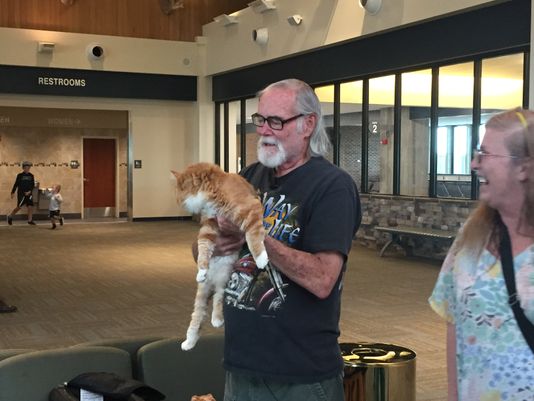 Cat Found 18 Months Later - 900 Miles Away
Cat Found 18 Months Later - 900 Miles Away
Bobby, the cat, went missing from his home in Great Falls, Montana, more than 18 months ago. However, his 73-year-old owner, Kyle Peterson, never stopped trying to find him. That persistence has now paid off. Bobby had been found roaming the streets of Fallon, Nevada after being picked up as a stray by Animal Control. A scan of the Bobby's microchip revealed that he was more than 900 miles from home. With the microchip information, the shelter got in touch with Bobby's owner. Mr. Peterson, after hearing how far his cat had travelled, believes that Bobby wandered away from home and accidentally hopped on a train that passes across the street from his home.
 Listen to the entire Podcast of this show (#1040)
Listen to the entire Podcast of this show (#1040)





